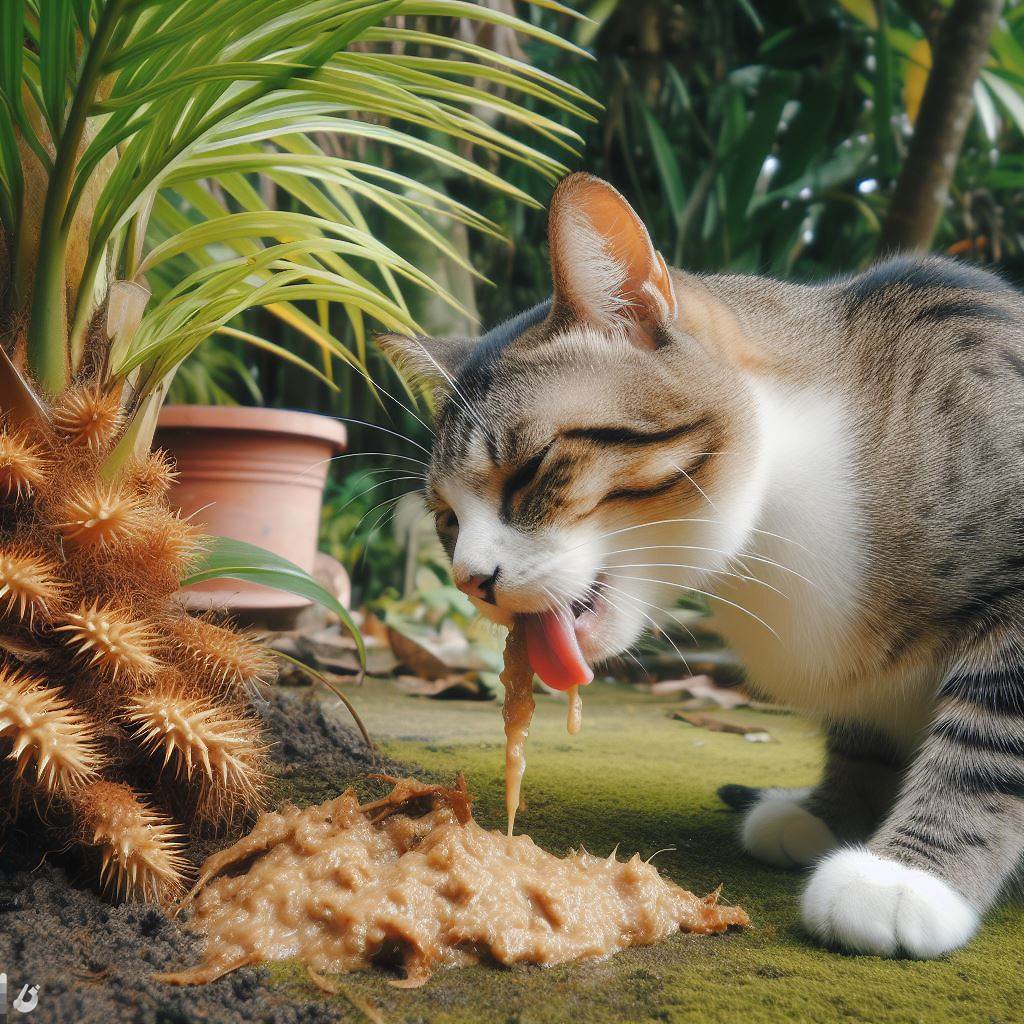Palm trees are a popular choice for landscaping in warmer climates. With their tropical look and hardy nature, palm trees add a decorative element to yards and gardens. However, some varieties of palm contain toxins that can be harmful or even deadly to household pets like cats.
As a cat owner, it’s important to understand which types of palm pose a danger and what preventative steps you can take to keep your furry friends safe. This comprehensive guide covers everything you need to know about palm toxicity for cats, from the identification of hazardous species to first aid if poisoning occurs.
Arm yourself with knowledge so you can help protect the cats in your life from accidentally ingesting poisonous palm leaves or plants.
Identifying Toxic Palm Plants
Not all palm varieties are toxic. However, there are a few common landscape palm types that contain toxins that can harm cats and dogs. Here are the most dangerous palm species to watch out for:
Sago Palm
The sago palm (Cycas revoluta) is extremely toxic and poses the most danger to pets. All parts of the sago palm contain the poison cycasin. Just a few bites of a sago palm leaf can be fatal to cats. Initial ingestion of the toxins causes vomiting, diarrhea, and lethargy. Without treatment, it leads to severe and potentially fatal liver failure. Even plants kept indoors away from pets contain the toxins.
Tip: Completely avoid sago palms if you have pets. Do not plant them in your yard or keep them as houseplants. Even a small bite can be deadly.
Areca Palm
The areca palm (Chrysalidocarpus lutescens) contains various alkaloids and compounds that can irritate your cat’s digestive tract. The fronds are covered in spiky thorns that can poke or cut your cat’s throat and mouth. Ingestion causes vomiting, excessive salivation, and oral irritation.
Tip: Keep areca palms out of reach of cats to prevent chewing on the spiky fronds. Seek veterinary care if you notice symptoms.
Majesty Palm
The majesty palm (Ravenea rivularis) leaves and stems also contain insoluble calcium oxalates similar to areca palms. While not as toxic as a sago palm, ingestion causes mouth and throat irritation and potential obstruction in the digestive tract.
Tip: Place majesty palms and other spiky palms out of reach to prevent chewing and injuries.
Date Palm
The fruit of the date palm (Phoenix dactylifera) poses toxicity risks from cyanide compounds in the pits, skins, and leaves. However, the ripe fleshy part of the date fruit is safe.
Tip: Prevent access to any part of the date palm plant besides the ripe dates. Seek veterinary care if unripened dates with pits or skins are ingested.
Coconut Palm
The coconut palm (Cocos nucifera) contains tannins in the leaves that can cause mild stomach upset. However, the coconut flesh and water are safe.
Tip: Avoid allowing access to chew on coconut palm leaves or stems. Only provide flesh and coconut water.
Dangers of Palm Plants for Indoor Cats
Cats who live exclusively indoors can also be exposed to poisonous palm plants. Houseplants like parlor palms, areca palms, and majesty palms are common in home decor. But their spiky fronds and toxicity pose risks for curious felines who may chew on or ingest the leaves.
Indoor palm dangers include:
- Injury from spines and spikes: Palm fronds have pointed, sharp ends that can poke, cut, or scratch your cat’s mouth, tongue, and esophagus if chewed on. This causes pain and damage to tissues.
- Intestinal blockage: The fibrous nature of palm leaves makes them difficult to digest. Swallowed fronds can clump together and cause a dangerous gastrointestinal blockage.
- Toxicity: Cats who nibble on sago palms can face liver failure and death without swift veterinary treatment. Other palms may also contain irritating toxins.
Tip: Keep all indoor palm plants out of reach of cats. Place them somewhere your cat cannot access to nibble on the fronds.
Signs of Palm Poisoning in Cats

If you suspect your cat has ingested part of a toxic palm plant, look for these common symptoms:
- Drooling or excessive salivation
- Difficulty swallowing
- Vomiting
- Diarrhea
- Decreased or loss of appetite
- Pawing at the mouth
- Lethargy or depression
- Jaundice (yellowing gums, skin, whites of eyes)
- Seizures
Sago palm poisoning also causes acute liver failure, which is indicated by yellowing of the skin and gums, vomiting, diarrhea, dark urine, seizures, and bleeding disorders.
Tip: Seek emergency vet care immediately if ingestion of a sago palm is suspected. The toxins work quickly and can be fatal within a day or two without aggressive treatment.
For other palm plant ingestion, look for symptoms like vomiting, drooling, or loss of appetite. Call your vet or pet poison control hotline if you notice any signs of distress.
Deterring Cats from Palm Plants
The best way to prevent palm plant poisoning is to deter your cats from nibbling on or ingesting the leaves in the first place. Here are some tips to make palms less tempting:
- Use criss-crossing double-sided tape over the surface of the pot to deter scratching or chewing. Cats dislike the stickiness on their paws.
- Spray fronds with pet-safe citrus scents. Cats dislike the smell of citrus. Apply to leaf tips.
- Place an overturned pot in the palm’s pot so the spiky leaves are not as accessible.
- Keep indoor palms out of reach. Put them somewhere your cat can’t access, like on high shelves, hanging from the ceiling, or behind closed doors.
- Try Ssscat automatic air spray deterrents. The motion-activated hiss and air spray startles cats away.
- Use aluminum foil or plastic carpet runners around the palm pot perimeter. The texture deters scratching.
- Apply a bad-tasting deterrent gel to the fronds. Products like Fooey Training CAT work well.
- Consider cat-safe non-toxic plants instead of palms for indoor gardening. Catnip, spider plants, or wheat grass are safer.
Tip: If your cat is determined, you may need to remove palm plants from your home entirely. Your pet’s safety should come first.
Emergency Treatment if a Cat Ingests Palm
If you believe your cat ate part of a toxic palm, quick action is critical. Here are the first-aid steps to take:
- Induce vomiting if ingestion was recent. Use 3% hydrogen peroxide or call your vet for directions. Do not induce vomiting if symptoms have already begun.
- Collect a sample of the vomit or plant. Take it to the vet appointment for identification.
- Rinse mouth out with water to remove plant hairs. Avoid swallowing.
- Call your vet or emergency animal hospital immediately. They can assess if treatment is needed based on the type of palm ingested.
- For sago palm poisoning, seek aggressive liver support therapy. Hospitalization with IV fluids, blood work monitoring, vitamin K, and possibly a liver transplant may be needed.
- For other palms, treat symptoms supportively. Anti-nausea medication, IV fluids, bowel protectants, and gastrointestinal treatments are used. Surgery may be needed for an intestinal blockage.
Tip: Never wait “to see” if a cat develops symptoms after ingesting a toxic plant. Get same-day veterinary assessment and proactive treatment to improve the chance of recovery.
Preventing Outdoor Palm Hazards for Cats
Palm trees are ubiquitous in tropical and subtropical landscapes. While the neighborhood palms likely pose less risk than a highly toxic sago palm, dangers still exist outdoors. Here are some tips to reduce risks:
- Properly identify palm species in your yard and neighborhood. Have any sago palms removed or fenced off so pets cannot access them. Ask your landscaper if unsure.
- Trim lower fronds and frond debris. Prevent the buildup of fallen leaves on the ground that cats could nibble on.
- Cover the soil beneath palms with stones, mulch, or another barrier so cats cannot dig in the dirt. The roots and bulbs of some palms contain toxins.
- Keep pets indoors during landscaping work. Palms are often trimmed with power tools that can fling debris into yards. Ingesting freshly cut leaves poses a higher toxicity risk. Wait to allow re-access until the area is cleaned up.
- Fence off palm trees to restrict access. This is the only way to fully palm-proof your yard. A 6-foot wood or lattice fence does the job.
- Monitor outdoor playtime. Accompany cats when allowing them outside access so you can intervene with any nibbling on plants quickly.
Tip: Opt for cat-friendly shade trees and shrubs instead of planting toxic palm varieties. There are many non-toxic, pet-safe landscaping alternatives.
Are Cat Palm Chew Toys Safe?
You may see cat toys at the pet store labeled as crispy palm cat chews. These are made from palm leaf fronds curled into tubes. They can satisfy some cats’ craving for nibbling greenery. However, it’s important to verify the safety of these products before purchasing.
Here are some tips for evaluating palm cat chews:
- Ensure it is not made from toxic sago or areca palm materials. Opt for a safer parlor, betel nut, or coconut palm instead.
- Look for non-toxic certifications. Check that reputable bodies like the ASPCA have approved the chew as safe.
- Supervise use. Do not leave palm chews unattended, as chewing smaller pieces could pose a choking risk.
- Inspect for splintering or shredding. Discard products once they start fraying apart, as loose fibers could cause obstructions if swallowed.
- Stop use if vomiting or choking occurs. Discontinue use of the product if you notice distress or reactions.
Tip: The safest bet is to avoid palm leaf chews altogether and opt for alternative materials like seagrass or woven raffia. Monitor all chew toys closely regardless of material.
Quick Facts on Cats and Palm Toxicity
- Sago palms are extremely toxic and cause liver failure in cats and dogs. All parts of the plant, including leaves, contain the poison cycasin.
- Spiky fronds on areca, majesty, and parlor palms can poke or cut a cat’s mouth and esophagus during chewing. Ingestion causes irritation.
- In addition to liver toxins, palm leaves contain insoluble calcium oxalates that can cause oral pain and intestinal obstructions if swallowed.
- Indoor palm houseplants should be kept completely out of reach of cats to prevent nibbling and injury.
- Seek immediate veterinary treatment if any ingestion of a toxic palm plant occurs. Quick action improves recovery chances.
- Properly identifying species of outdoor landscape palms can help assess toxicity risks to outdoor cats in your neighborhood.
- Use humane deterrents like citrus scents, tough textures, and cat-safe anti-chew sprays to prevent nibbling on palm plants.
The Bottom Line
While not all palm plants are toxic, several popular varieties do pose risks to cats who may nibble on or ingest the leaves and fronds. Sago palms are extremely poisonous, while areca, majesty, and parlor palms primarily cause mouth injuries but can also obstruct the intestines if swallowed. Through vigilance and cat-proofing both inside and outside your home, you can help protect your feline friends from the dangers certain palm plants present. Keep toxic varieties out of paw’s reach and seek immediate veterinary care if any ingestion is suspected. With preventative measures, we can keep our cats safe to lounge, play, and flourish while still enjoying the tropical flair that palm trees provide.




